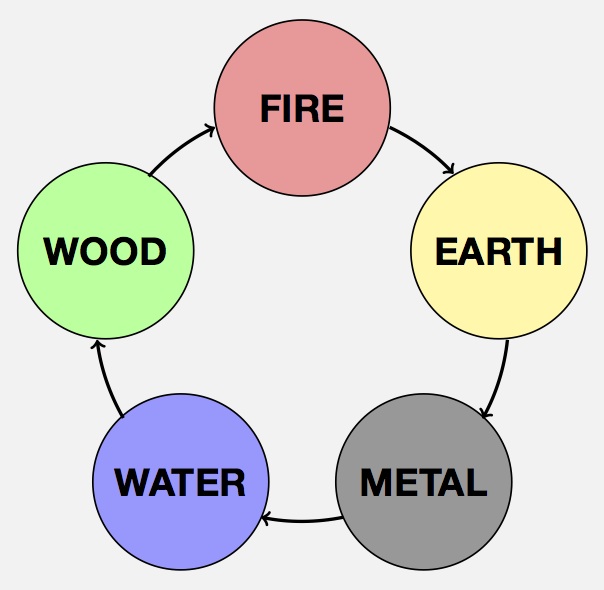The Five Elements
One of the greatest strengths of the Chinese philosophy of medicine is how it is based on observation. The Chinese were great observers and great correlators. For example, they noticed that individuals who struggled with a loss or bereavement were very likely to succumb to a respiratory condition in the months following the loss. Those same individuals were more prone to tennis elbow symptoms. They noticed that those who frequently suffered stiff lower backs were more likely to have issues with hearing and vision and yet also have issues with fear. They noticed that those individuals who were very structured and organised in many aspects of their lives were also rather more prone to muscular cramps and were also subject to issues with fat digestion and gall bladder function.
Unlike the reductionist methodologies of modern Western-based medicine, the Chinese did not discount any of these correlations if they did not have a causal mechanism linking the observations. Instead they wove a philosophy around all of the correlations, linking the themes and ideas and working it into a practical approach to understanding how the human body and mind works when in health and how things go wrong in ill-health.
The Chinese did not for example, dismiss the correlation between gall bladder function and muscular cramping simply because they did not have a neurological or biochemical link connecting these phenomena. Instead they created a philosophy whereby the same influences that controlled gall bladder function also controlled cramping and decision making too. This then enabled physicians to understand better the patient symptoms when the totality of their symptoms were considered.
A significant acceptance of this philosophy is that the physical body, our behaviours and our emotions are not inseparable. How we feel and how we act are intimately connected with our physical being and physiological function. Equally our physiological well-being will impact our behaviours and emotions. There is reciprocity both in terms of understanding symptoms but also in treating symptoms: sort the physiology and the behaviours and emotions will improve; treat the emotions and behaviours and the physical body will improve.
One of the key parts of this created philosophy is the Theory of the Five Elements (or Phases). To make studying and understanding the human condition more manageable, the influences were grouped into five headings – Wood, Fire, Earth, Metal and Water. My previous example of those struggling with loss succumbing to respiratory conditions and tennis elbow they placed under the Metal grouping. Into this same grouping they added the function of the large intestine (the organ of elimination – “letting go”), the lungs (our link to the respiratory conditions) and the skin (which they considered functioning like a third lung). The beauty of this grouping is that whenever patients presented symptoms that fell within this Metal collection, the physician could understand and treat those symptoms using acupuncture points that assisted the large intestine and lungs. This is the core of the Five Element system.
Because the Chinese philosophy also considered the body in health (not just in ill-health) it gives useful insights into our personalities on our day-to-day experiences. You do not have to be ill for an analysis of the Five Elements to be beneficial! It is thought that for each one of us, there is one particular element that influences us more than any other. This is often referred to as your Constitutional Factor. Whilst we are influenced by each of the elements to different extents and in different phases of our lives, generally the influence of one element tends to predominate.
So we can often use the phrase “I am a Wood type” meaning that Wood is my Constitutional Factor. This would signify that the characteristics of the Wood element most influence me, my physical being, my behaviours and my emotions. That does not mean that I cannot be influenced by the other elements. As I have described above, tennis elbow is strongly associated with Metal types. This does not mean Wood types cannot experience tennis elbow – they most certainly can. But for Wood types this is not a common or dominating condition. For Metal types however it may well be.
You will also see that for each of the Constitutional Factors there are certain behaviours and emotions that are strongly associated. For example, anger is associated with Wood types. Now a word of explanation here: For a Wood type, anger is an issue. That could mean a Wood type can experience and express anger all too often and often in inappropriate situations. Equally though a Wood type may not express anger at all, being passive and calm even in situations where perhaps expressed anger would be useful. Some Wood types could be both depending on the situation and context! In either situation, the Chinese model would consider these extreme responses to anger as inappropriate and a sign that anger is an ‘issue’ for the individual. Someone who is not a Wood type would probably only express anger when it is appropriate to do so, not express it when inappropriate and move-on when it has been expressed. This would be considered a balanced relationship with anger and indicate that the individual may well not be a Wood type.
So the inability to express an emotion or a behaviour associated with a Constitutional Factor, could just as strongly indicate that you are influenced by that particular element as if you readily and regularly express that emotion.
Next – learn about the Resonances with each Element
